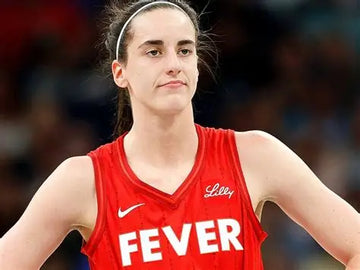Caitlin Clark vs. Angel Reese: Breaking Down the Rivalry, Clark's Dominance, and the WNBA's Growing Pains
by Nyden Kovatchev on Jul 15, 2025

The 2023-2024 WNBA season has been one of the most exciting, controversial, and divisive in recent memory. At the center of it all? Two names: Caitlin Clark and Angel Reese. What began as a collegiate rivalry has now exploded onto the professional stage, dividing fans, stirring heated debates on social media, and spotlighting deep-rooted issues in the WNBA—from inconsistent officiating to questionable marketing strategies.
In this article, we’ll explore the roots and rise of the Clark-Reese rivalry, dig into why Caitlin Clark is, by almost every measure, the better basketball player, and expose the WNBA’s failures to properly elevate and protect one of the most marketable athletes in league history. It’s more than just a rivalry—it’s a case study in talent, optics, and opportunity.
Origins of the Rivalry
Their 2023 NCAA Championship game became a viral sensation. While Iowa lost, the game’s defining moment was Reese’s use of John Cena’s "You Can’t See Me" taunt toward Clark—payback for similar antics by Clark earlier in the tournament. The media frenzy that followed cemented both players as cultural figures, though with very different reputations. Clark was seen as the next great basketball mind; Reese as the fiery antagonist.
Fast forward to the WNBA, and the animosity didn’t cool down—it intensified. Games between the Indiana Fever and the Chicago Sky have become must-watch TV, fueled by hard fouls, jawing between players, and polarizing fan reactions. But beyond the theatrics, a simple truth emerges: Caitlin Clark is the superior basketball player.
Caitlin Clark: A Generational Talent
Let’s not mince words—Caitlin Clark is a once-in-a-generation player. Her impact on the court and the culture of basketball is undeniable. In her rookie WNBA season, she’s already breaking records and carrying a franchise on her back.
Skillset and Versatility
Clark’s range is virtually limitless. She shoots with confidence and consistency from well beyond the three-point arc, opening up the floor and forcing defenses to stretch in ways they’re not used to. Her court vision is elite, threading no-look passes through traffic, running fast breaks with poise, and elevating her teammates.
She leads all rookies in scoring and assists, often putting up double-doubles against veteran defenders. Unlike many young players, she isn’t afraid to take the final shot—or be held accountable for a miss. That level of composure is rare.
Leadership and Basketball IQ
Clark is more than just numbers. Her leadership is evident in how she galvanizes her teammates, reads defensive schemes, and adapts mid-game. She carries herself with the maturity of a veteran, and her interviews reflect a deep understanding of the game’s nuances. She doesn’t just play basketball—she studies it.
Marketability
There’s also no question that Clark is the face of women’s basketball right now. She’s bringing record-breaking ratings to the WNBA, drawing in new fans, selling out arenas, and increasing jersey sales. The league should be building its brand around her—but it isn’t. We’ll get to that.

Angel Reese: Grit, Toughness, and a Chip on Her Shoulder
Angel Reese deserves credit. She plays with unmatched passion and has an impressive rebounding ability. Her presence in the paint, emotional energy, and commitment to hustle plays give her team an edge.
But as a player, she’s still developing. Her shot selection is questionable, her free-throw shooting is subpar, and she lacks the range or finesse that Clark brings. Reese’s style of play is more physical, which contributes to her frequent foul trouble and sometimes reckless defense.
Where Clark’s game is finesse and strategy, Reese’s is raw emotion and physicality. There’s room in the league for both styles—but one clearly translates to long-term greatness, and it isn’t Reese’s.
The WNBA’s Officiating Problem
If the Clark-Reese saga has revealed anything, it’s how broken the officiating system is in the WNBA. Clark, despite being the league’s biggest draw, is consistently subjected to hard, borderline dirty fouls—often without proper punishment. Reese herself has been at the center of controversy for fouling Clark hard on multiple occasions, including incidents where a flagrant call seemed warranted but wasn’t made.
The inconsistency isn’t just frustrating—it’s dangerous. The league has a responsibility to protect its players, especially its stars. Letting Clark take hit after hit without adequate enforcement sends a terrible message and risks her health.
Even worse, it appears that officials are hesitant to call fouls against more aggressive players like Reese out of fear of backlash or accusations of favoritism. This creates a hostile environment that discourages skillful play and rewards brute force.
Why the WNBA Isn’t Promoting Caitlin Clark Enough
Despite her star power, Clark often seems like an afterthought in the league’s official promotional material. Why?
Some suggest it’s an attempt to appear unbiased, to avoid the perception that one player is getting special treatment. But let’s be honest: leagues build around stars. The NBA didn’t hesitate to elevate LeBron James, nor did the NFL shy away from putting Patrick Mahomes front and center. Clark deserves the same treatment.
Others believe it’s political—that promoting Clark too heavily could stoke tensions or criticism from certain social groups. But hiding her brilliance out of fear undermines the sport. The WNBA needs to lean into what’s working. Clark is working. She’s drawing attention, ratings, and revenue. That’s not favoritism. That’s business.

Clark vs. Reese: More Than Just a Rivalry
In many ways, Clark and Reese represent a larger cultural clash—style vs. substance, strategy vs. swagger, skill vs. emotion. The public perception of both players is shaped as much by media narratives and social media discourse as it is by what happens on the court.
Clark’s calm demeanor and surgical execution appeal to purists of the game. Reese’s brash confidence resonates with fans who value emotion and authenticity. Both archetypes have their place, but when it comes to building a dynasty or elevating the league, Clark is the foundation.
Final Word: The Future of the League Hangs in the Balance
The WNBA stands at a crossroads. It has an opportunity to ride the wave of popularity that Caitlin Clark is bringing to the game, or squander it by trying to force parity where dominance exists.
Promoting Clark doesn’t mean excluding others. It means recognizing excellence and growing the league through its most potent asset. That’s what every successful league in the world has done—and what the WNBA must do if it wants to thrive.
The Clark-Reese feud may be entertaining, but it’s also a mirror—reflecting the league’s potential and its flaws. One is a generational superstar capable of carrying the WNBA into a new era. The other is a talented role player still finding her place.
It’s time the league—and the fans—acknowledged the difference.
Let’s not wait until it’s too late.

- #CaitlinClark #AngelReese #ClarkVsReese #ClarkReeseRivalry #CaitlinClarkEffect #AngelReeseHype #ClarkReeseDebate #WNBARivalries #ClarkVsReeseShowdown,
- #PromoteWomensSports #ElevateTheGame #ProtectOurStars #GrowTheGame #SupportWomensBasketball,
- #SportsDebate #BasketballCulture #GameChanger #NextGenBasketball #BasketballBeef #HardFoulsAndHype #RespectTheGame #FutureOfWNBA,
- #WNBA #WNBARivalry #WNBA2024 #WNBARookies #WNBADrama #WomenInSports #WNBANews #WNBADebate #BasketballTalk #BasketballFans,
- angel reese,
- Caitlin Clark,
- Caitlin Clark Indiana,
- Caitlin Clark wnba,
- wnba





